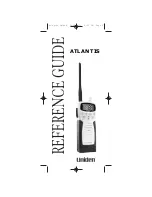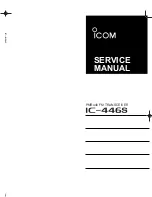
60
Detail Test Procedure for ELT ID Programming and Self Test:
Turn the main switch from the "OFF" position to the "ARM" position. The
Buzzer sound and the 2 Green ON lights shall illuminate for 4 seconds, then
extinguish. This is to allow coding programming during the next 20 seconds window
and self-test for 1 second thereafter.
The ELT may be ID coding programming during the aforementioned 20
seconds window period. If no programming happened the ELT will then enter the
Self Test Mode for 1 second thereafter.
Self Test takes 25 sec. Self-test results (after 25 seconds,) is:
If the self-test is passed,
the Green ON light is steadily extinguished and
no buzzer
sound
.
ELT swept Tone must be silent on the 121.5 MHz VHF Radio.
If the self-test is failed
, the Green ON light flashes as defined below:
1 flash:
Internal Data stored in Memory at fault.
2 flashes:
Distress ID stored in Memory at fault.
3 flashes:
Battery voltage is low < Useful Life Battery Voltage setting.
4 flashes
: Vcc supplies for F3, F2, or F1 at fault.
5 flashes:
F3 RF power level < 33 dBm @ 406.028 MHz
7 flashes:
F1/F2 VHF RF power level < 17 dBm @ 121.5/243 MHz.
9 flashes:
PLL locked in F3 or F1 or F2 at fault.
Continuous flash:
no F3/F2/F1 RF output power, ELT shuts down completely.
Note:
The self-test mode that transmits a 406 MHz test code pulse monitors certain
system functions before returning to the ARM mode. The 406 MHz test pulse is
ignored by any satellite that receives the signal, but the ELT uses this output to check
output power and correct frequency.
Self-test is 520 ms long message burst on the 406 MHz signal. Synchronization
pattern is 011 010 000.
Self-test is then 121/243 MHz (VHF) Continuous Wave during 1s.
During Self Test, ELT swept Tone must be silent on the 121.5 MHz VHF Radio.
If No Antenna or No coaxial cable connected, the ELT may or may not 5 flashes.
2.4.5 ELT Self Test Schedule:
We recommend that the ELT be tested every month. Follow the steps outlined above.
Total allowable test is 60 minutes as determined by FAR 91.207 and RTCA DO-204.
After this time has been accumulated a 3-flash error may be presented after the self-
test. The battery must be replaced at this point for the ELT to remain in compliance.
Always follow ELT testing requirements per local or national authorities.
Summary of Contents for AK-451 Series
Page 23: ...23 Figure A Front view of ELT Figure B 3 D view of ELT ...
Page 32: ...32 Figure 3 Mounting Tray with Clamp Holder for ELT AF AP ...
Page 37: ...37 Figure 6 Whip Antenna Model AK 451 017 1B ...
Page 39: ...39 Figure 2 1 2 ELT with mounting tray holder and adapter tray ...
Page 42: ...42 Figure 7 1 Rod Antenna AK 451 017 2A 1 ...
Page 45: ...45 Figure 8 Blade Antenna AK 451 017 3A ...
Page 48: ...48 ...
Page 51: ...51 Figure 11 Remote Audio Buzzer Monitor P N 451018 ...
Page 79: ...79 Figure 18 ELT Front Panels Main Unit and Remote Unit ...
Page 84: ...84 ELT S Top Label Figure 19 Automatic Portable ELT AP with integral antenna Survival ELT S ...
Page 108: ...108 ...
Page 109: ...109 ...
Page 110: ...110 ...
Page 111: ...111 ...
Page 112: ...112 ...
Page 113: ...113 ...
Page 114: ...114 ...
Page 127: ...127 ...
Page 128: ...128 ...
Page 138: ...138 Table 1 List of all available Protocols ELT Non Location Protocols ...
Page 139: ...139 ELT Location Protocols User Location Protocols ...
Page 151: ...151 ...
Page 152: ...152 ...
Page 153: ...153 ...
Page 154: ...154 ...
Page 155: ...155 ...
Page 156: ...156 ...
Page 157: ...157 ...
Page 158: ...158 ...
Page 159: ...159 ...
Page 160: ...160 ...
Page 161: ...161 ...
Page 162: ...162 ...
Page 163: ...163 ...
Page 164: ...164 ...
Page 165: ...165 ...
Page 166: ...166 ...
Page 167: ...167 ...
Page 168: ...168 ...
Page 169: ...169 ...
Page 170: ...170 ...
Page 171: ...171 ...
Page 172: ...172 ...
Page 173: ...173 ...
Page 174: ...174 ...
Page 175: ...175 ...
Page 176: ...176 ...
Page 177: ...177 ...
Page 178: ...178 ...
Page 179: ...179 ...
Page 180: ...180 ...
Page 181: ...181 ...
Page 182: ...182 ...
Page 183: ...183 ...
Page 184: ...184 ...
Page 185: ...185 ...
Page 186: ...186 ...
Page 187: ...187 ...
Page 188: ...188 ...
Page 189: ...189 ...
Page 190: ...190 ...
Page 191: ...191 ...
Page 192: ...192 ...
Page 193: ...193 ...
Page 194: ...194 ...
Page 195: ...195 ...
Page 196: ...196 ...
Page 197: ...197 ...
Page 198: ...198 ...
Page 199: ...199 ...
Page 200: ...200 ...
Page 201: ...201 ...
Page 202: ...202 ...
Page 203: ...203 ...
Page 204: ...204 ...
Page 205: ...205 ...
Page 206: ...206 ...
Page 207: ...207 ...
Page 208: ...208 ...
Page 209: ...209 ...
Page 210: ...210 ...
Page 211: ...211 ...
Page 212: ...212 ...
Page 213: ...213 ...
Page 214: ...214 ...
Page 215: ...215 ...
Page 216: ...216 ...
Page 217: ...217 ...
Page 218: ...218 ...
Page 219: ...219 ...
Page 220: ...220 ...
Page 223: ...223 Japan Civil Aviation Board Approval ...
Page 225: ...225 ...
Page 226: ...226 This page is left blank on purpose ...
Page 227: ...227 ...
Page 228: ...228 ...
Page 229: ...229 ...
Page 230: ...230 APPENDIX K MATERIAL SAFETY DATA SHEET FOR BATTERY ...
Page 231: ...231 ...
Page 232: ...232 ...
Page 233: ...233 ...
Page 234: ...234 ...
Page 235: ...235 ...
Page 236: ...236 ...
Page 237: ...237 ...
Page 238: ...238 ...
Page 239: ...239 ...
Page 240: ...240 ...
Page 241: ...241 ...
















































